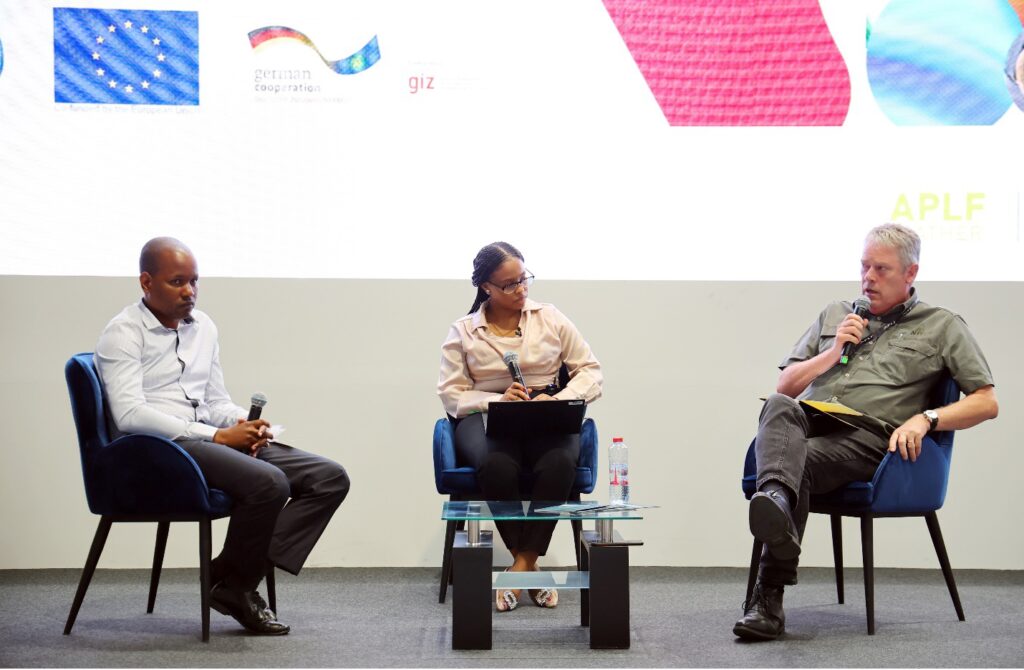29 May 2023
As part of the Joint Action SIPS activities, 5 leather stakeholders were supported to participate in the Asia-Pacific Leather Fair (APLF) with the technical and financial assistance of the Joint Action SIPS. The APLF 2023 was a great opportunity to learn about the latest trends, products, and technologies in the leather value chain for four manufacturers of leather goods from Eswatini, Zimbabwe, Lesotho, and Botswana (mkla.africa, ZERI LEATHER –“True African Brand” Good Hope Leather Products, Ostiladam Creations) and one tannery from Namibia (Nakara (Pty) Ltd).
In keeping with SADC Secretariat’s strategy of promoting environmentally sustainable leather production systems, the Joint Action SIPS also facilitated a panel discussion on Environmental Compliance and Waste Management Solutions in the leather value chain on the APLF main stage.

Sefalana Lobelo, Junior Technical Advisor at Deutsche Gesellschaft für Internationale Zusammenarbeit (GIZ) GmbH in Botswana, provided more information: “The project also strengthens the regional leather value chain and related services in selected Member States by working closely with livestock farmers, tanneries and leather manufacturers to increase the quality of leather and leather products.”
While working on raw material supply and procurement strategy for the transportation of hides and skins to countries with tanneries in the SADC region and the promotion of the leather manufacturing industry in Tanzania, Sefalana noted that a pivotal goal for SADC is to overall enhance business, entrepreneurial and subject matter knowledge skills.
“Within the project, we engage in various activities, specifically collaborating with livestock farmers and facilitating the transportation of hides and skins to tanneries. Our focus is on introducing environmentally sustainable practices and implementing traceability systems. A key aspect of our work is raising awareness among stakeholders about environmental compliance and promoting sustainable methods that can be adopted throughout the leather value chain (LVC).”
Jonathan further explained that they worked with stakeholders within the LVC to find sustainable solutions and to change the narrative that the leather industry is a polluting industry. Working towards building a closed loop circle, he asserted: “We strive to show the world that we can also produce leather that is sustainable, of high quality and unique to Southern Africa.
Sefalana continued, that the way they encourage leather value chain stakeholders is through enhancing their knowledge on the different project activities. The Joint Action SIPS facilitates trainings on traceability systems, best animal husbandry practices, marketing and alternative tanning methods. Jonathan added that the project’s main goal is to support SADC’s regional integration so that stakeholders in the leather value chain can access new markets, share knowledge and technologies for overall economic growth in the region.
In Context With around 350 million people living in this area, the SADC Member States have considerable economic potential. Their natural resources and the size of the common regional market are important competitive advantages. However, trade between the SADC countries and with the rest of the world is still largely characterized by export of unprocessed raw materials. National economies lack the modernization, competitiveness, and diversification of products to promote closer regional trade. Regional strategic goals for peace and security are not implemented consistently, therefore, it is difficult for SADC countries to increase their share of the world trade by exporting processed products. Thus, regional integration to improve regional trade is in some cases overshadowed by other more pressing concerns. The work of SADC in the economic sector is focused on industrialization in the region and on the promotion and facilitation of trade.
SADC is currently implementing the Regional Indicative Strategic Development Plan (RISDP) 2020 – 2030. One of the priorities of RISDP is to enhance SADC’s regional integration agenda through enhanced industrialization. In this regard, SADC aims to improve its value chains including those related to the development and promotion of the leather value chain. The Cooperation for the Enhancement of SADC Regional Economic Integration (CESARE) Programme aims to support SADC’s efforts in this area. Under the European Union and the German Ministry for Economic Cooperation and Development (BMZ) financing, the Joint Action SIPS, part of the CESARE Programme, aims to enhance private sector participation in the regional leather value chain to establish and scale up all stages of the value chain, including the manufacturing of high-quality and affordable leather products. Moreover, it aims to increase regional production capacity, boost regional competitive advantage, strengthen every sector of the value chain and reduce dependency on imports.
Disclaimer: The content and views expressed herein can in no way be taken to reflect the official views of the EU, BMZ or GIZ.
We bring leather, material and fashion businesses together: an opportunity to meet and greet face to face. We bring them from all parts of the world so that they can find fresh partners, discover new customers or suppliers and keep ahead of industry developments.
We organise a number of trade exhibitions which focus on fashion and lifestyle: sectors that are constantly in flux, so visitors and exhibitors alike need to be constantly aware both of the changes around them and those forecast for coming seasons.